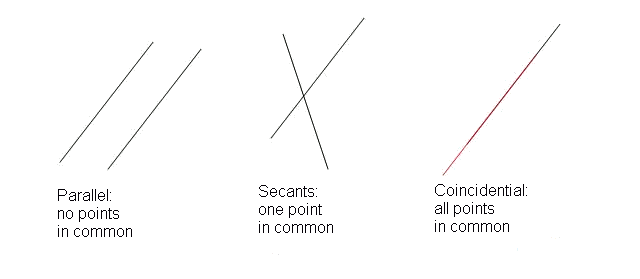Two straight lines on the plane can be secant, parallel or coincidental.
The following drawing shows 3 possible situations:

Let's see how to distinguish between these three cases. It is necessary to mention that there exist multiple ways of doing this, depending on the equation of the straight line that we have.
Obviously all of them will be equivalent and if we know how to change from one equation of the straight line to another any method of the following ones will work.
Let's see the geometric and algebraic ways of doing the problem:
From a geometric point of view, if we consider two coincidental straight lines to be a particular case of parallelism, we have two straight lines in the plane that can only be parallel or secant.
When are two straight lines parallel?
When their director vectors are parallel.
When are two vectors parallel?
When one is proportional to the other. That is, if we have the vectors
In coordinates, if
Therefore, we already have a geometric way of finding the relative position of two straight lines - by seeing whether their director vectors are parallel or not:
- Parallel vector directors:
- If the straight lines have a point in common they are coincidental and they are the same.
- If the straight lines do not have any common point they are parallel.
- Non parallel director vectors: The straight lines are secant.
It is important to note that, in general, two parallel straight lines have director vectors of proportional components and equal slopes.
Example
Consider the straight lines
At first, we look for director vectors of both straight lines.
For
For
Therefore, if we divide component by component we have:
We solve the system of equations formed by the equations of both straight lines to find the intersection point:
Therefore the intersection point between two straight lines is
From a more algebraic point of view, we can analyze the relative position of two straight lines
For example, if we consider two straight lines
We have the system of equations:
where it takes the intersection points as a solution between the straight lines
-
If the system has no solution, the straight lines are parallel.
-
If the system has infinite solutions, the straight lines are coincidental.
- If the system has 1 solution, the straight lines are secant.
Example
Consider the following pairs of straight lines, and to find the relative position between them.
a)
We solve the equations system:
And the solution of the system is
b)
We solve the equations system:
And as the system has no solution we can conclude that these two straight lines are parallel.
c)
We solve the equations system:
And as the system has infinite solutions, these two straight lines have to be coincidental.
